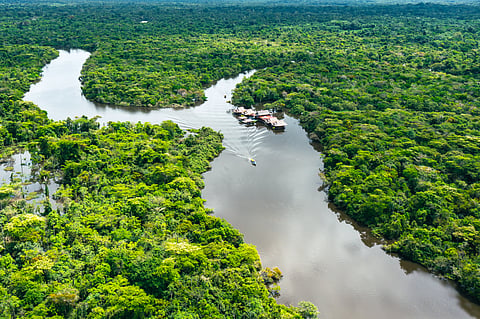

In climate discussions, the year 2030 appears again and again like a bright line drawn across the future — a deadline, a warning and a promise all at once. It is the year by which scientists say the world must halt and begin reversing deforestation if we hope to stay within the 1.5°C limit of the Paris Agreement. But can the world truly stop the loss of forests in just a few years? The question feels large, almost overwhelming, until you look closely at what is happening today in the world’s most important rainforest: the Amazon.
Right now, global climate negotiators are gathered in Belém, deep inside the Amazon region, for COP30 — a location chosen deliberately to remind everyone of what is at stake. It is one thing to talk about forests in faraway conference halls. It is another to hold those talks in the heart of the world’s largest tropical rainforest, where every fallen tree feels like a countdown. At a joint press conference, leaders from WWF and Greenpeace stood before the media and said what many scientists have been repeating for years: “The time for symbolic gestures is over. We need a roadmap. We need action.” They were direct, almost blunt, because the science itself has stopped speaking in gentle tones.
The Amazon is approaching what experts call an irreversible tipping point. If deforestation and degradation continue, the forest could lose the ability to generate its own rainfall. Parts of it could shift into dry savannah. Rivers could shrink. Wildlife could disappear faster than it can adapt. And once this shift begins, there is no known way to reverse it. Kirsten Schuijt of WWF warned that the world simply cannot meet the Paris goals without ambitious action on forests. Carolina Pasquali of Greenpeace added that there is “no 1.5-degree solution without forests” and insisted that COP30 must produce a time-bound, concrete plan rather than vague promises.
All of this raises the core question: is it actually possible to stop global deforestation by 2030? The honest answer is that it is difficult, but not impossible. The barriers are enormous — political conflict, illegal logging, land-grabs, climate-created wildfires and enormous global demand for commodities like beef, palm oil and soy. Yet the pathway is clearer today than it has ever been.
One reason for that clarity is the growing role of Indigenous peoples and local communities. Across the Amazon, studies show that forests managed by Indigenous groups have significantly lower deforestation rates than those under other forms of control. Their knowledge of the land, water and climate is profound, built over centuries of close observation. At COP30, Indigenous voices have been louder than ever, insisting that meaningful protection must begin with recognising their rights and leadership. When Pasquali said the world “must deliver for communities and nature”, she was pointing to the evidence that successful forest protection happens when the people who live in forests are central to the decisions.
Another reason for cautious hope lies in the push for international cooperation. Brazil’s president, Luiz Inácio Lula da Silva, has called on COP30 to produce two roadmaps — one for phasing out fossil fuels and another dedicated entirely to forests. For years, forest protection was treated as a side issue in climate talks, overshadowed by energy and finance. Now, forests are being recognised for what they have always been: natural machines that cool the planet, store carbon, shape rainfall and hold biodiversity that keeps ecosystems stable. A world that protects forests gains time — time to adapt, time to innovate, time to breathe.
There are challenges. Some countries rely heavily on agriculture expansion or timber exports. Some regions face weak law enforcement. Others struggle with political instability. And global consumption patterns continue to fuel pressure for more land. But many of these problems have solutions that are already known. Stronger monitoring systems, satellite tracking, community-based patrols, restoration programmes, financial incentives for conservation, sustainable farming methods, and fair trade practices — these are not ideas waiting to be invented. They are tools waiting to be scaled.
The real gap, as WWF put it, is not ambition but implementation. Many nations have signed pledges for zero deforestation. Fewer have backed those pledges with strong budgets, clear timelines or binding commitments. This is why the call for a “roadmap” matters. A roadmap forces governments to answer difficult questions: Where will funding come from? Who will monitor progress? What happens if a country falls behind? How will Indigenous communities be protected? And who ensures transparency?
Stopping deforestation by 2030 is not just a technical challenge; it is a race against time. As forests shrink, the climate grows hotter. As temperatures rise, fires become easier to ignite. As fires spread, forests weaken further. It is a cycle that can accelerate quickly if left unchecked. But the opposite is also true. Protect forests, and they protect us — stabilising climate, slowing warming, nourishing rain cycles, and storing carbon in roots, leaves and soil.
The world has succeeded in large environmental efforts before. Countries phased out ozone-depleting chemicals. Entire rivers have been cleaned. Endangered species have recovered when given a chance. These successes happened because nations chose collective action over delay. Forests now need the same unity, urgency and discipline.
So can the world stop deforestation by 2030? The answer depends on what happens now, not later. It depends on whether COP30 produces a real action plan, whether governments listen to Indigenous leaders, whether companies change the way they source materials, and whether global citizens understand that the Amazon is not just a regional forest but a planetary system.
The year 2030 is not a distant milestone. It is close enough to feel real but far enough to allow change. The world still has a narrow window to honour that deadline — and the Amazon, standing at the edge of its tipping point, is waiting for a decision that cannot be postponed any longer.